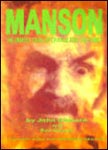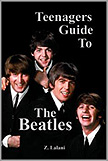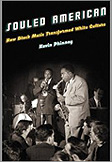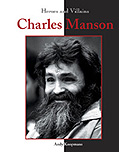|
When it comes to necessary reading regarding Charles Manson, two titles immediately come to mind: "The Family" by Ed Sanders and of course "Helter Skelter" by Vincent Bugliosi. Both of these titles have been around since the early '70s, with subsequent updated versions. But in 1971 there was a third book on Manson called "The Garbage People" by John Gilmore - which unfortunately went out of print. However, the book is back with updated information and a new title, "Manson: The Unholy Trail of Charlie and the Family".
What makes the updated version of Gilmore's book so vital to the understanding of Manson? Well, not only does it include personal interviews between Gilmore and Manson that I've never seen before, but it also includes information from personal interviews with Bobby Beausoleil. Beausoleil has often been portrayed by the media as a mere minion of Manson, but this book sets the record straight, illustrating the sometimes-volatile power-struggle between Manson and Beausoleil. The book also gives some interesting background biography information on Beausoleiel. And speaking of Manson's music, a point is brought up that Gary Hinman promised to finance a recording session for Charlie.
Rather than the outlandish Helter Skelter or debatable drug-burn motives, Gilmore shows that the often overlooked and obvious motive was right under our noses: Manson's ever growing resentment of a society that "failed" him, from his regularly non-existent mother, to the string of juvenile homes, to a barrage of prisons, and finally the rejection of his music. It was simply "payback time" in the eyes of Manson. The book quotes an ex-follower of Manson that speaks volumes: "Charlie told us, you butcher what they dream of being. You kill off these gilded replicas of fame and happiness, and when you smash these you can go right into the heart of the dark…"
"Manson: The Unholy Trail of Charlie and the Family" is vital reading to the understanding of the myth that is Charles Manson, and goes a long way towards separating that myth from the truth. But beware: the book does include some very graphic crime scene and morgue photos.
Curious initiates to the magic of The Beatles have it easy these days, as there is a plethora of books on the Fab Four, with just about every aspect of the represented in the print. But back in the mid '70s in a small town in Texas, I had to be content with our town library's lone Beatles entry: "The Beatles" by Hunter Davies; plus the one Beatles book at our middle-school, whose titles now escapes me, but it told a very condensed history of the band, with psychedelic illustrations of the band in lieu of actual photographs. Family trips to the 'big city' helped me enlarge my meager library with such great '70s books such as "The Beatles Forever" by Nicholas Schaffner and "The Beatles: An Illustrated Record" by Roy Carr & Tony Tyler. Looking back at what Beatles-related books were available at book stores then (and this was the day before the BIG book chains we see today), Beatles titles were a drop in the bucket compared to what can be found today at modern book stores. Yep, today's Beatles fans have it easy! Over my 30+-year fascination with the band, I've often been asked by curious Beatles-deficient folks just WHAT book (and of course ONE record) is the best introduction to the undisputed best rock 'n roll group of all time. Well, now that quandary is solved with "Teenagers Guide to The Beatles" by Z. Lalani. The book gives a concise, fact-filled narration of The Beatles from their individual childhoods, through Beatlemania, their solo years, to the Anthology project, and finally the deaths of two of the Beatles. Additionally, the book is chocked full of photos (some of which I had never seen before-always a plus!), information on Beatles' CDs, "Beatle Bits" of relevant trivia spread throughout the book, the "A Little Help from their Friends" section with a whose-who listing of relevant Beatle-people, and a selected bibliography. And of course there is the now-necessary "internet resources" page, with all the relevant listings for further journeys into "Pepperland". And, when it comes to Beatles books, I am a stickler for the facts and HATE books, which perpetuate known miss-truths as fact! While this book leaves out some of the more scandalous sections of Beatle history (such as drug use and Brian Epstein's…well, "preferences") it does give a very accurate description of the facts. I meticulously searched the book to find any factually errors and can happily say that I found NONE! Although there is an "albums and songs" index and each Beatles release is covered within the context of the story, there is no concise "discography" of Beatles' musical releases. That means that those unfamiliar with Beatles records and their titles must scan the book to find the information. This is my only critique of the book. Otherwise, this book is an excellent Beatles primer, guaranteed to help the next generation of Beatles fans as they discover the reason WHY The Beatles are the best rock band bar none. Help the Beatles' fans of tomorrow by getting them this book today! You wont be sorry.
In a mere 343 pages, Kevin Phinney seems to pull off the impossible: give both an accurate and concise history of how black music transformed white culture. This seems like a monumental task, especially when you consider that Phinney is examining several genres of music - from minstrel music, ragtime, jazz, blues, rock and roll, soul, disco, and rap! Of course just about everyone that is influential is mentioned or written about: Scott Joplin, Bessie Smith, Billie Holiday, Robert Johnston, Muddy Waters, Blind Lemon Jefferson, Hendrix, Sly Stone, etc. But there are also those lesser-known artists that are finally given exposure, like the Fisk Jubilee Singers. Along the way, black music influenced white artists such as Stephen Foster and George Gershwin. The book also has one of the best essays I've ever seen on the rise of Elvis Presley and what he represented. There is also a very interesting section on the popularity of disco and its very quick and brutal backlash. Although it contains almost encyclopedic volumes of information, Kevin Phinney's "Souled American: How Black Music Transformed White Culture" doesn't read like a droll college textbook, but rather like an entertaining and fascinating story of musical influences that finally gives credit where credit is due.
Ace Frehley was always my favorite member of KISS and I was really surprised by this book. I half expected one of those boring rock 'n roll tell-all scandal books, like the horribly bad "Dream on: Livin' on the Edge With Steven Tyler and Aerosmith". While "Into the Void...With Ace Frehley" by Wendy Moore is a tell-all book with its fair share of scandals involving the band KISS, it doesn't read like it was written by a disgruntled ex-lover with an axe to grind. Instead, it tells both the harrowing tale of a good girl that ended up a heroin addict and a first-hand account of the often fantasy & illusion-filled world of a rock star. Not only does the book shatter the myth that KISS (mainly Ace Frehley and Peter Criss) had cleaned up their act and were sober for the Reunion tours, but it paints an unflattering picture of Ace Frehley, who seems to be living in an almost perpetual fantasy world that he naively believes. Ace sadly appears to be the 'hard rock version of Elvis', even to the point of having a copy of Physician's Desk Reference at his disposal for any drug questions. Ace's deep seeded personal confidence issues are described, and these seem to be at the root of his drug problem. While the book mainly concentrates on Ace, of course the inner dynamics of the band are described in first-hand accounts. Gene Simmons personality is an open book and anyone familiar with his own autobiography know all about Gene - so there is nothing new revealed about him here. However, the mystery that is Paul Stanley is often brought up in cryptic descriptions. Moore hints that she knows the real "scandal" involved, but her conscience prevents her from spilling it out in a book. I actually admire Moore for this move. That takes class in the cutthroat scandal book world where everything has a price! Besides, I can only take ONE tearing-down of a rock star at a time. A great account of the dark side of rock stardom.
Andy Koopmans' "Heroes and Villains: Charles Manson" is the newest in the Lucent Books biography series of controversial people. In less than 100 pages, Koopman touches upon nearly every important aspect of the Charles Manson story, delivering an accurate, quick-reading description of one of the most notorious crime figures of our generation. Manson's trouble youth is well represented, complete with a fascinating map of Manson's Adolescence. While there are no photos from the actual murder scenes, there are plenty of other photos throughout the book. The only problem is - some of these photos are taken from TV movies and are not the real deal at all. But to be fair, these photos ARE labeled, so it is not just a research error. Plus, the book contains a great resource section, with relevant books and websites. If you are curious about Charles Manson, but don't yet want to tackle the 600+ page opus that is Vincent Bugliosi's "Helter Skelter" (probably the best known Manson book), then the Reader's Digest format of "Heroes and Villains: Charles Manson" will help you decide if you want to delve more into the Manson saga.
|

 Manson: The Unholy Trail of Charlie and the Family
Manson: The Unholy Trail of Charlie and the Family
 Teenagers Guide to The Beatles
Teenagers Guide to The Beatles
 "Souled American: How Black Music Transformed White Culture"
"Souled American: How Black Music Transformed White Culture"
 Into the Void...With Ace Frehley
Into the Void...With Ace Frehley
 Heroes and Villains - Charles Manson
Heroes and Villains - Charles Manson